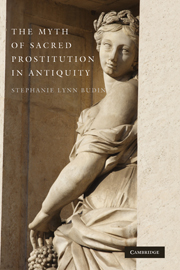Book contents
- Frontmatter
- Contents
- Acknowledgments
- Abbreviations
- THE MYTH OF SACRED PROSTITUTION IN ANTIQUITY
- 1 Introduction
- 2 The Ancient Near Eastern Data
- 3 The So-Called “Evidence”
- 4 Herodotos
- 5 In the Footsteps of Herodotos: Lucian and “Jeremiah”
- 6 Pindar Fragment 122
- 7 Strabo, Confused and Misunderstood
- 8 Klearkhos, Justinus, and Valerius Maximus
- 9 Archaeological “Evidence” from Italy
- 10 The Early Christian Rhetoric
- 11 Last Myths
- Bibliography
- Index
- Index Locorum
2 - The Ancient Near Eastern Data
Published online by Cambridge University Press: 18 August 2009
- Frontmatter
- Contents
- Acknowledgments
- Abbreviations
- THE MYTH OF SACRED PROSTITUTION IN ANTIQUITY
- 1 Introduction
- 2 The Ancient Near Eastern Data
- 3 The So-Called “Evidence”
- 4 Herodotos
- 5 In the Footsteps of Herodotos: Lucian and “Jeremiah”
- 6 Pindar Fragment 122
- 7 Strabo, Confused and Misunderstood
- 8 Klearkhos, Justinus, and Valerius Maximus
- 9 Archaeological “Evidence” from Italy
- 10 The Early Christian Rhetoric
- 11 Last Myths
- Bibliography
- Index
- Index Locorum
Summary
Any chapter or article one cares to look at regarding sacred prostitution either suggests or states openly that the practice emerged in the ancient Near East (ANE). Thus S. Hooks, “[T]he existence of sacred prostitution in Israel and the ancient Near East is commonly accepted and made the starting point for the interpretation of numerous biblical and extra-biblical texts …” As J. Assante noted, “Mesopotamia is believed to have been the home of ‘the oldest profession’ and to have originated sacred marriage rites and cult prostitution that later diffused into other cultures.” I. Haas wrote, “On the evidence of the Biblical passages that have stressed a licentiousness in polytheistic religions, it has been taken for granted that temple prostitution was practiced among the Semitic peoples in their fertility cults honouring mainly Baal or the goddess of love, especially in Babylonia and Phoenicia–Canaan, and that this practice penetrated the Israelite religion because of the influence that Canaanite culture exerted on it.” E. Ferguson, writing about Greco-Roman religion in the context of early Christianity, claimed that “Not only was prostitution a recognized institution, but through the influence of the fertility cults of Asia Minor, Syria, and Phoenicia it became part of the religious rites at certain temples.” As Hans Conzelmann published in 1967 concerning sakrale Prostitution, “Diese ist im semitischen Orient verbreitet.” In 1986 Gerda Lerner traced the origins of prostitution itself to fertility rites, and then sacred prostitution, which first emerged in Mesopotamia.
- Type
- Chapter
- Information
- The Myth of Sacred Prostitution in Antiquity , pp. 14 - 47Publisher: Cambridge University PressPrint publication year: 2008



